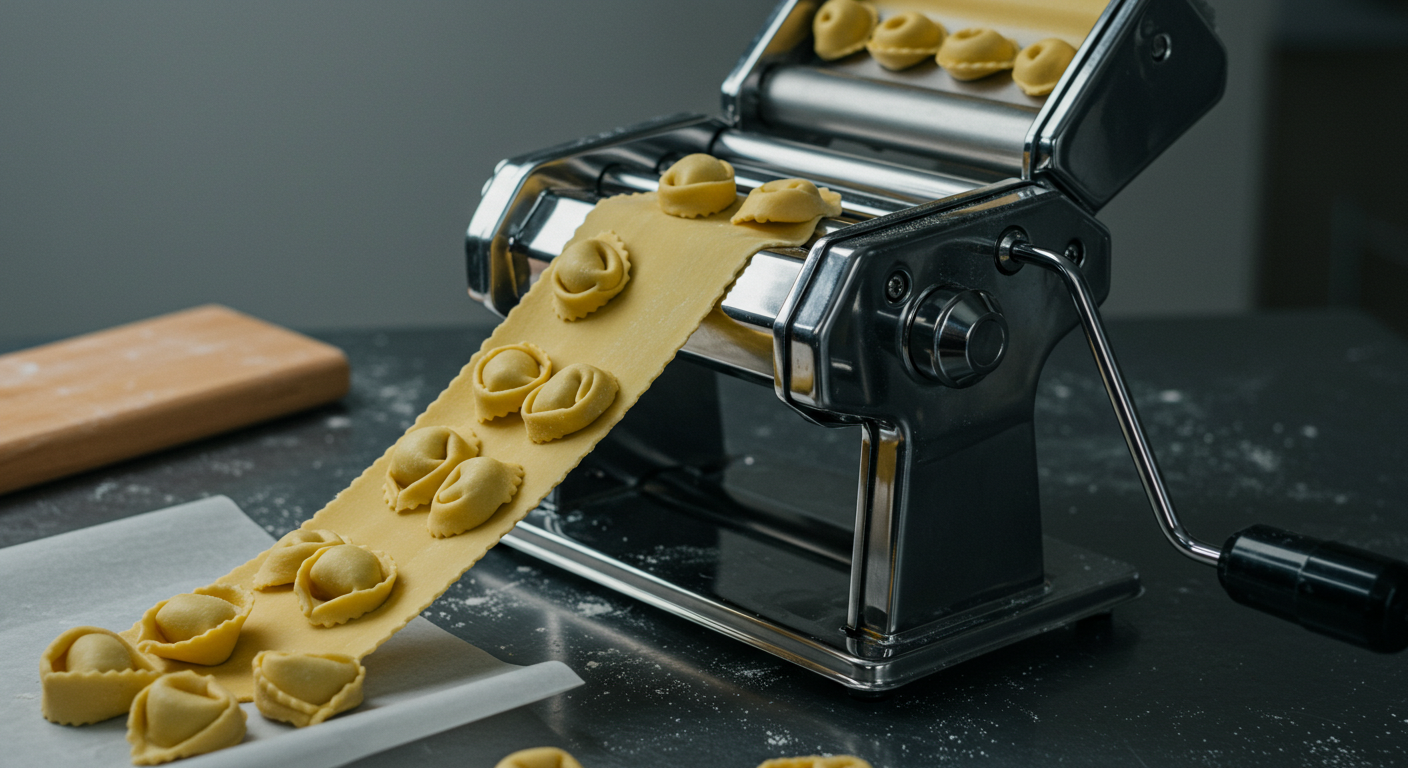
Tortellinatrice: Crafting Perfection in Pasta Making
The tortellinatrice represents one of the most innovative advancements in pasta production. Originating from Italy’s rich culinary tradition, this machine has completely transformed how tortellini — the iconic ring-shaped pasta — is made. In the past, artisans spent hours manually shaping each piece of tortellini. Today, with the help of the tortellinatrice, pasta makers can combine tradition with technology, maintaining the authentic flavor and texture while increasing efficiency.
The word tortellinatrice itself comes from tortellini (a small, filled pasta) and -trice, the Italian suffix indicating a machine or tool. It signifies not just automation but precision, craftsmanship, and consistency — qualities that define Italy’s world-famous pasta industry.
Understanding the Role of the Tortellinatrice in Modern Pasta Making
The tortellinatrice plays a central role in modern pasta production facilities and artisan kitchens alike. It ensures that every piece of tortellini maintains a uniform size, weight, and filling ratio. This consistency is crucial for both taste and presentation, especially when producing pasta on a commercial scale.
Below is a table comparing traditional handmade tortellini versus those produced by a modern tortellinatrice:
| Feature | Handmade Tortellini | Tortellinatrice-Made Tortellini |
|---|---|---|
| Production Speed | Slow, depends on artisan skill | Fast, continuous output |
| Shape Consistency | Varies by batch | Perfectly uniform |
| Labor Requirement | High, needs skilled workers | Low, requires machine operator |
| Filling Control | Manually adjusted | Precisely measured by the machine |
| Ideal for Large-Scale Production | No | Yes |
This table clearly shows how the tortellinatrice bridges the gap between traditional craftsmanship and modern productivity, ensuring that quality remains uncompromised while meeting growing demand.
The History and Invention of the Tortellinatrice
The tortellinatrice was born out of necessity. As Italian cuisine spread globally, the demand for authentic pasta increased. Small artisanal pasta makers found it challenging to maintain quality while keeping up with production. This led engineers and food technologists in Italy’s Emilia-Romagna region — the home of tortellini — to design a specialized machine capable of replicating the delicate hand-folding process.
Early prototypes appeared in the mid-20th century, often hand-cranked or semi-automatic. These machines mimicked the human hand’s motion, folding and sealing each piece with precision. Over time, modern tortellinatrici incorporated digital controls, stainless-steel components, and programmable settings, allowing for different pasta shapes, sizes, and fillings.
How the Tortellinatrice Works
At its core, a tortellinatrice is designed to automate three essential steps: dough preparation, filling insertion, and pasta shaping.
-
Dough Sheet Formation – The machine rolls the dough into thin, even sheets using adjustable rollers.
-
Filling Injection – A calibrated nozzle inserts the exact amount of filling into each dough piece, ensuring balance and flavor.
-
Folding and Sealing – Mechanical arms or rollers fold the dough around the filling and seal it perfectly, forming the distinctive tortellini shape.
The entire process takes only a few seconds per piece, yet the results mirror traditional handmade tortellini in taste and appearance.
Here’s another useful table summarizing the key components of a tortellinatrice:
| Component | Function Description |
|---|---|
| Dough Roller | Flattens dough to consistent thickness |
| Filling Feeder | Dispenses uniform amounts of filling |
| Folding Mechanism | Shapes and seals tortellini automatically |
| Control Panel | Adjusts speed, pressure, and filling ratio |
| Cutter/Separator | Separates individual tortellini from dough sheet |
The Tortellinatrice in Artisan and Industrial Use
While industrial pasta factories rely heavily on the tortellinatrice, small artisanal pasta shops also use compact versions of the same machine. These smaller models allow local chefs to maintain traditional recipes while improving efficiency.
For instance, boutique pasta makers in Bologna use semi-automatic tortellinatrici to handle part of the process, finishing each piece by hand to add a signature touch. This blend of automation and human craftsmanship keeps the soul of Italian pasta alive, ensuring authenticity in every bite.
Industrial-grade tortellinatrici, on the other hand, are capable of producing thousands of tortellini per hour. These machines are integrated with conveyor systems, quality sensors, and even optical scanners that detect imperfections before packaging.
Innovations and Advancements in the Tortellinatrice
Modern tortellinatrici are more than just mechanical devices — they’re smart, programmable systems. Technological advancements have introduced features such as:
-
Digital Interfaces: Touchscreens for real-time adjustments.
-
AI-Assisted Production: Intelligent sensors that detect dough consistency and filling texture.
-
Hygienic Design: Stainless steel components for easy cleaning and compliance with food safety standards.
-
Versatility: Capability to switch between tortellini, ravioli, cappelletti, and other stuffed pastas.
This evolution shows how the tortellinatrice has kept pace with both consumer demands and global food safety regulations.
Economic and Cultural Impact of the Tortellinatrice
The tortellinatrice has not only shaped production but also influenced Italy’s culinary economy. By enabling mass production without sacrificing authenticity, it has allowed small pasta brands to reach international markets.
Culturally, the machine symbolizes Italy’s blend of innovation and heritage — preserving traditional food art while adapting to modern efficiency. Many culinary schools even teach students how to operate the tortellinatrice as part of their pasta-making curriculum, ensuring that future chefs can master both manual and mechanical techniques.
Maintenance and Care of a Tortellinatrice
For any pasta producer, maintaining the tortellinatrice is crucial to ensure consistent quality. Regular cleaning prevents dough buildup, while routine inspections of rollers, injectors, and cutters maintain precision.
| Maintenance Task | Frequency | Purpose |
|---|---|---|
| Cleaning Dough Rollers | Daily | Prevents sticking and dough contamination |
| Lubricating Gears | Weekly | Ensures smooth mechanical motion |
| Checking Fillers | Weekly | Maintains filling accuracy |
| Inspecting Seals | Monthly | Avoids air pockets in tortellini |
This proactive approach not only extends the lifespan of the machine but also guarantees food safety and operational efficiency.
The Future of Tortellinatrice Technology
As global demand for fresh pasta continues to grow, the tortellinatrice will likely see further innovations. The next generation of machines is expected to integrate IoT technology, allowing remote monitoring, predictive maintenance, and recipe automation. Additionally, sustainable materials and energy-efficient motors will reduce the carbon footprint of pasta manufacturing.
Chefs and engineers alike are working to refine how texture, flavor, and appearance can be further perfected through controlled automation. This ensures that even in a high-tech kitchen, the spirit of traditional Italian cooking remains at the heart of every dish.
Conclusion
The tortellinatrice stands as a remarkable testament to human ingenuity and culinary passion. It bridges the old and the new — preserving the artistry of handmade tortellini while introducing the precision and scalability of modern technology. Whether used in a small trattoria or a large pasta plant, this machine embodies the Italian dedication to excellence in food.
Through continuous innovation, the tortellinatrice continues to shape the future of pasta-making, ensuring that every plate of tortellini served around the world carries a taste of authentic Italian tradition — beautifully crafted, perfectly folded, and irresistibly delicious.


